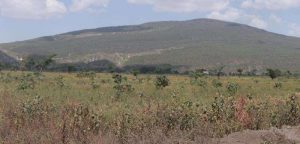
Credit: David Pyle
The great Rift Valley that runs through Ethiopia has played a pivotal role in human evolution. It is both the location of the earliest fossils of anatomically modern humans and, later, become an important route for human migrations ‘out of Africa’.
Today, it is home to more than ten million people, a major hub for tourists, and the location of important transport links. The main Ethiopian Rift Valley is also one of the largest fields of volcanoes on Earth – although this status may not be obvious from the remnants of the sprawling tumbledown hills that break through the dusty flats of the rift valley floor. Here, Africa has been slowly pulling apart for millions of years. As the continent pulls apart, the crust extends and thins, promoting the rise of magma from the depths of the Earth’s mantle. None of these volcanoes is thought to have erupted since the early 19th century, and several are now the focus of development of geothermal energy potential.
In a new paper published in the journal Nature Communications, Will Hutchison, an Oxford DPhil student, and a team of collaborators from the UK, Ethiopia and the USA, shed a little more light on the violently explosive past of several of these rift volcanoes. Using a combination of field work (to reconstruct the deep history of the volcanoes) and isotopic age dating techniques, the researchers find that at least four of the volcanoes of the main Ethiopian Rift Valley suffered colossal eruptions between about 320,000 and 170,000 years ago. These were very significant eruptions – perhaps of the scale of the eruption of Krakatoa in Indonesia in 1883. They would have buried the rift floor in volcanic ejecta, disrupting water sources and habitats across wide areas, with the collapsed remnants of the volcanic edifices forming great ‘calderas’, or craters, in the rift floor.
This pulse in volcanism coincides with the arrival of Homo sapiens in the region around 200,000 years ago and raises the question of to what extent these changes in the landscape and environments occupied by our earliest human ancestors might have influenced human evolution and migration. The recognition that explosive volcanism in the rift occurs in bursts also poses some interesting geological questions, and future inter-disciplinary research is needed to understand the scale of eruptions at other large volcanoes of the rift, their causes, and their wider consequences.
Reference:
William Hutchison et al. A pulse of mid-Pleistocene rift volcanism in Ethiopia at the dawn of modern humans, Nature Communications (2016). DOI: 10.1038/ncomms13192
Note: The above post is reprinted from materials provided by University of Oxford.









